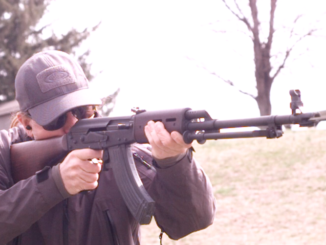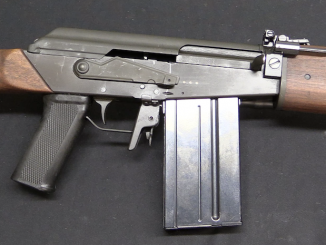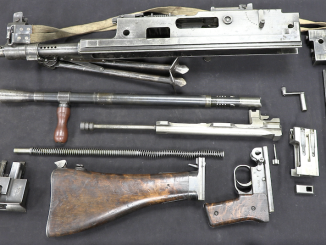Finland’s standard light machine gun going into the Winter War was the LS-26, a gun which did not succeed in field use. It was complex and cumbersome, and Finnish troops quickly replaced it with captured Russian DP-27 LMGs. Part of the problem of the LS-26 was it’s recoil-operated design. Finnish military authorities specified a recoil-operated mechanism for their LMG in light of the success of the recoil-operated heavy Maxim guns in Finnish service. Gas operation was quickly recognized as a superior system for light machine guns, but too late to stop adoption of the LS-26.
In the early 1930s, Aimo Lahti did design a gas-operated LMG, heavily influenced by the Czech ZB-26 system. A handful of prototypes were made by VKT, looking for both Finnish military acceptance and international sales. The gun was made in several calibers, most notably 7.62x54R for Finland and 7.92x57mm Mauser for export. However, bureaucratic issues prevented its consideration by the Finnish Army, and the timing was too late for exports. The L-34 was significantly lighter and simpler than the LS-26, and it was performed quite well in Finnish trials – which did not happen until the 1950s. By that time, the Finnish military was looking for an intermediate-caliber belt-fed gun, and the L-34 was not suitable regardless of its performance.
Many thanks to Sako for providing me access to film this L-34 from their reference collection!




This is what I’d call “standard LMG solution” for its time, perhaps even more elegant than ZB26. Note location of gas tap – it is way forward as on Czech gun, as opposed to Bren which has it at about 2/3 of of Bbl length.
All these guns have one problem however – they are not exactly material/ labour efficient. Locking into receiver requires large machined central component with lots of chips going into waste bin.
WIth the advent of sintering and laser induced 3d printing, can those chips be refined more and used in those processes? Personally I think that extruded aluminum is the way of the future with constructing receivers but reusing those chips would at least be a decent upgrade.
The extruded/ cast Aluminum receivers as you say, are the current trend. It makes sense since it saves machining out of forging. The way to tell is transitions/ splines of following surfaces. They are easy to discern from machine-cutter path.
Of course this common sense application is possible if locking into receiver can be avoided.
I’m afraid modern manufacturing techniques came too late for this 85-year-old design.
Exactly.
It’s like a steam powered plane. Technically, quite doable, but…
Every product is designed based on the manufacturing method.
True, for some reason, most modern designers do not understand this.
Naturally, the output is not exactly what I wanted, and not at all what was expected.
You’d have a hard time adapting an old design that was predicated on the ideas of it being produced with then-current manufacturing technology. What’s needed are new designs meant to be produced on the new machinery, not rehashes of things meant to be produced under totally different factory conditions.
You only have to look at the grief they came to trying to produce 20mm cannon back in WWII, going from the old-school machined forgings to stamped technology similar to the automobiles of the day. They’d have been better off starting with a clean-sheet design wrapped around stamping technology than trying to somehow adapt that which Oerlikon had designed with the idea of having it made by fussy Swiss watchmaker types…
Ridiculous comment (unless its trolling) as it is not the cost of the chips, which is trivial, but of a machine time and wear – the one that makes these “chips”.
Yupp. A chunk of even high grade steel is rather cheap. The machines and tools needed for manufacturing and the people using them are not and most of the time limit the output.
It’s ridiculous to try to mill what is meant to be stamped or cast what is meant to be milled.
The aggregate share of the cost of material, energy, tools and equipment in the cost of the product is not even half, but in the worst case a quarter.
And the use of “advanced” methods of production in reality does not reduce the cost, but often increases.
Because this increases the cost of more qualified labor, which is the lion’s share.
Therefore, any product whose design is competently optimized (in terms of strength and accuracy) for manufacturing on primitive conventional machines is cheaper than on CNC, despite the apparent increase in productivity and quality of the latter.
In machinegun-building there is no place for high precision for which CNC is needed (despite the fact that this is precision engineering). But it is vitally important to correctly define and distribute gaps and rational organization of all processes to minimize man-hours.
And all that modern manufacturers achieve, who are trying to do according to “advanced” technologies for design of a century (or two) age, is an increase in cost and a decrease in quality.
And all that modern manufacturers achieve, who are trying to do according to “advanced” technologies for design of a century (or two) age, is an increase in cost and a decrease in quality.
– I personally can not get past plastic in guns (above pistols), any way how you turn it, still feels and looks toyish to me. I even pondered of a gun made of plastic that would have some kind of steel coating on top, just to hide that surface, no matter if the steel would rust and thus be detrimental in that aspect…
I agree.
While it wouldn’t be feasible with a tipping-bolt design, it might be possible with a tipping-block design to relocate the block forward to lock into a barrel extension.
“(…)not exactly material/ labour efficient.(…)”
That being said estimated unit price was less than half of Lahti-Saloranta LMG, according to http://www.jaegerplatoon.net/ALMOST1.htm
Estimated production cost for L-34 run around 4,500 FIM (Finnish marks), while per unit cost manufacturing cost for Lahti-Saloranta M/26 was about 10,000 FIM.
“(…)one problem however – they are not exactly material/ labour efficient(…)”
How it does compare to later Lahti’s gas-operated weapon material efficient-wise namely L-39 https://modernfirearms.net/en/anti-tank-rifles/finland-anti-tank-rifles/lahti-l-39-eng/
?
Hi Daweo,
as much as these issues seem to be simple; aka to replace machined receiver with sheet metal one, they ae NOT. You always run into some snag of one kind or another. I have witnessed issues related to sheet metal-welded MG receiver. You would not believe how much hassle as involved regarding straightening afterwards, not o mention heat effected zones in guide rails, potential cracks in them and so on. It was almost nudging one to go back to machined/ riveted receiver instead. There is no easy win.
Beautiful gun, beautiful review. Thank you.
I keep playing around w/ turning the AR action upside down so an assistant gunner can quick change mags in the prone. Went so far as to mock one up on an 80% uncut lower, the reach to the top trigger isn’t bad, the cut pistol grip is just ugly. Sighting is w/ 2x 45 degree Pic rails w/ a red dot off to the side.
Rising locking block, like Lahti’s pistol!
Watching you remove the barrel made me wonder how difficult it would be with a hot barrel.
Thanks for another very good video Ian and congrats to SAKO for 100 years. There’s just something about Finnish firearms…
It’s nice to know, and yet depressing as hell, to find out that even Finland has its share of useless bureaucracy with regards to small arms procurement.
I think part of the reason for a lot of this is simply that the nature of the terrain in Finland is not exactly conducive to tactics that put a lot of emphasis on the machinegun. You do better with the SMG and rifle in close-in quarters like you find in the Finnish forests, and as such, they’ve not concentrated on the MG or relied on heavy use thereof to succeed tactically.
The Finns did not have the German disadvantage of “no conscription/no extensive reserve force”, and so they kept right on keeping on with the Jaakari light infantry tradition they’d picked up from the WWI German Jagers that trained the initial cadre of Finnish troops. Those guys were skirmisher/scouts who relied on woodscraft, initiative, and aimed individual rifle fire, so we shouldn’t be too surprised that the Finnish military tradition didn’t put a lot of reliance on the MG.
I respectfully disagree with someone I usually agree with. Jungle, woods and forest are usually a close range proposition, but also sometimes need an ability to reach out and touch things across clear-cuts, gorges, or other terrain features.
An LMG (lighter the better) is also really useful at close range woods stuff.
Not used in the way machine gunners are taught at machine gun school, but as conceptually a big SMG – from the shoulder or the hip. Lose the bipod (or put it in a ruck/Bergen/pack for special occasions) and other weighty ancillaries.
Something like an MG42 would be poor, for mobility and ammo resupply reasons.
Anything from a Bren to a Stoner 63 or a cut-down BAR all worked well decades ago.
And, in jungle, belts get stuck on stuff and collect crap. Box mags better.
SMGs are overrated in woods because trees stop their bullets, whereas an LMG shoots through them and hurt the guy behind them.
Regarding intermediate cartridge development in Finland it seems to be more like “heavyweight sub-machine gun” rather than “rifle but with less reach” see
9 x 35 AL-43 http://cartridgecollector.net/9-x-35-lahti-al-43
spawned by 6.5×55, but with 9 mm round nose bullet
9 x 40 LILJA http://cartridgecollector.net/9-x-40-lilja
akin to 9×19 Parabellum but longer
9 x 41 L-51 http://cartridgecollector.net/9-x-41-lahti-l-51
also 9 mm round nose bullet
I’m just pointing out the cultural features that would have militated towards their attitudes, not saying they’re right.
I can find a ton of useful things to do with a tripod-mounted MG system in the woods or jungle, but there are a lot of people who’d be equally likely to find it useless because they’re not from the same background and don’t share my mentality on how to use them.
When you get down to it, the choices we make about “how to fight” are mostly all cultural. And, while stereotypes can be useful to figure the other guys out, they’re not always either totally accurate or as long-lived as we assume.
Case in point for Finland–The Hakkapeliitta cavalry of Carl Gustav’s time. They were the stereotypical Finn “soldier type” that Europe thought of with regard to Finland and its people, but by the time of WWI, nobody ever put “cavalry” and “Finland” together as synonymous things.
You can, however, tease out some similarities in terms of how the Hakkapeliitta fought, and the Jaakari mentality of modern Finnish infantry. Things change, but they stay the same, as they say.
I agree with the above, bigger caliber and round in many cases is not just for range, but as you described it, to clear out the obstacles.
For example, .223 is known to deviate off course very easily, from hitting the leaves and branches even.
“(…)Finns did not have(…)disadvantage of “no conscription/no extensive reserve force”(…)”
Yes, but if they considered war with Soviet Union, they must take into account they will be at numerical disadvantage.
I assume (no knowledge) that they did, and reckoned that their best hope (as proved to be true) was a mixture of terrain and tactics. A bit like Switzerland, without the conscription/citizen army thing.
Point that I was making was that German MG doctrine and thinking came out of one overarching fact–No trained reserves. Thus, the emphasis on the MG as a means of maximizing their tiny numbers of trained men.
Finns didn’t have that problem, and so did not seek out a solution to it that led to the emphasis on the MG to the exclusion of trained riflemen operating in concert with each other. I suspect that had the Versailles Treaty not limited German military policies the way it did, and allowed them to maintain the trained reserve classes that they thought necessary, then the likely outcome would have been a much different set of tactics and armament choices. A counterfactual that we’ll never know the right answer to…
I think your Germany theory is interesting, though I’m not sure I completely buy it.
It’s hard to work out what the Heer were thinking at a time when much of it had to be underground.
I think you may also in your comments (Finland) underestimate both inherent military conservatism (this is what we’ve always done) and budgetary realities (you want a new suite of small arms; but the real priority is these new-fanged aeroplane and tank things, and everyone else seems fine with their WW1-vintage guns and so, if you are right, let’s come back to that in a few years…). Both of which, in addition to bureaucratic nonsense, I know you are very aware of
It’s not actually a theory; it’s historical fact. Von Seeckt and his crew of carefully selected staff officers worked through all the implications, and chose their course of action based on what they worked out.
Versailles sought to eliminate the huge advantage that the Germans had possessed in terms of trained manpower. None of the other armies in Europe could match the pre-WWI Imperial German Army in terms of their excellent reserve system that provided them with vast numbers of trained and prepared men. The French reserve system was good, but it did not meet the same standards as the Germans did. The British Territorials simply did not have the numbers, not being fed by a mass conscription system that mandated service.
Knowing that Versailles denied them their desired reserve classes of trained men, the Germans looked for ways to maximize their trained manpower, which is why the MG34/42 family were deliberately specified, designed, and procured. Concentrate the firepower in one place, with a crew serving it, and with the NCO (derived from the massively expanded von Seeckt Reichswehr) providing the experienced leadership.
I’ve been over some of the background material, and it makes for interesting reading. The Germans really did believe that the Imperial German Army had a key and essential role in national character development, and despaired of the fact that that role was going unfilled, not only in terms of military utility, but for other reasons across the entire society. Germany was pretty much alone in the status it accorded its NCO cadres; in the UK, those men were thrown into virtual poverty and put on the dole, once out of the forces. In German society, they’d be put to work in some low-level government job such as postmaster for some small town, or schoolteacher. The social status accorded those men made their jobs in the military both socially respected and highly sought-after, with the concomitant side-effects in terms of self-reinforcing behaviors for the cadres. Absent those things, they sought ways to overcome the perceived disadvantages they’d be at in the post-Reichswehr era, and thus… All that followed, with regards to the concentration on the MG and mortar systems and the deprecation of the individual weapons systems like the rifle? That flowed from that. There were reasons that they spent huge percentages of their available funding on the machinegun, and very little on the Kar98k… As in, they didn’t think that the rifle was worth all that much, past its purpose in defending the MG team.
“It’s difficult to translate.”
Isn’t that the first lesson of learning Finnish?
The late radio host Barry Farber was famous for being multilingual. He was practiced in 25 languages, but not all of them fluently.
He said he spent three days in his hotel room in Helsinki before figuring out enough Finnish to find the ground floor. 😉
Ian must have been in a library; we seemed to be speaking quietly and distinctly.
1) The Sampo has a position in Finnish myth rather like the Grail farther West
https://en.wikipedia.org/wiki/Sampo
2) As far as similarities with other LMG’s, for a given level of technology, engineering solutions tend to converge
1) – very interesting!
re. point 2:
this is true statement; technology is shared (not necessarily copied)
“An object in Finnish mythology that produces money and food from nothing” was really all that’s needed.
The Finns missed a trick by not adopting this machine gun. It seems better than a Bren. The solution to locking the bolt is particularly elegant.
If course it was made in the way of the 1930s, that is machined from steel by craftsmen, but one can hardly hold that against it. It certainly deserved to be successful.
Finland must be an absolutely awful place to be a firearms designer. No matter what you come up with, it’s competing with warehouses of FREE captured or forgotten Russian/Soviet weapons.
This kinda looks like the never built1896 browning design for a pump action shotgun
https://www.thefirearmblog.com/blog/2014/12/04/unproduced-browning-shotgun-patent-1896/
This is the link to the article about it